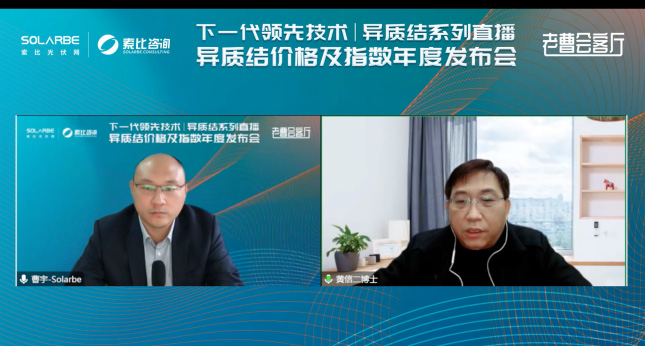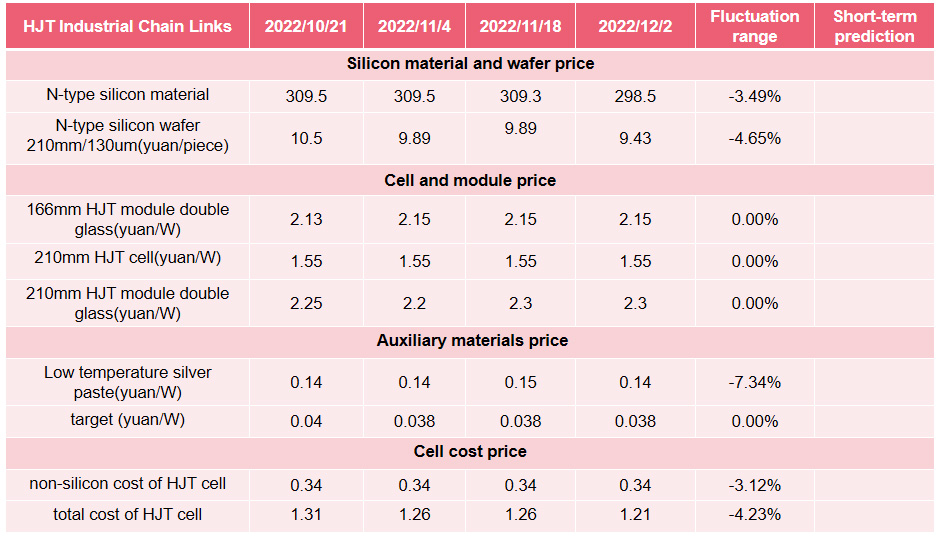On December 7, Annual HJT Price and HJT Index Release Conference sponsored by SOLARBE and Solarbe Consulting was successfully held online. Dr. Huang Xin'er, vice president of AKCOME Science and Technology Energy Research Institute, was invited to attend the conference and carried out in-depth discussions on the HJT industry chain price and index, cost reduction and profit increase path, photovoltaic technology progress and other hot topics together with Chief Analyst of Solarbe Consulting and HJT industry leaders to explore the way of development of HJT industry.
With the promotion and implementation of global “carbon neutral” goal, renewable energy such as photovoltaic and wind power has been gradually replacing fossil energy. In this context, the global photovoltaic market demand has surged and the industrial scale has expanded continuously. It is expected that the newly installed capacity of global photovoltaic market will reach 233GW in 2022. As the strategic commanding height of photovoltaic industry chain, the transformation of PV cell technology will determine the development direction of photovoltaic industry. With the conversion efficiency and production cost of PERC technology approaching the theoretical upper limit, N-type cell technology represented by HJT rises rapidly, which has attracted much attention from industry capital and energy market.
HJT, the Leading Technology of Next Generation
Based on the latest data of China Photovoltaic Industry Association and SolarPower Europe, Solarbe Consulting forecast the capacity of different cell technologies. Among them, the heterojunction capacity is expected to reach 218GW in 2025, with the market share exceeding 25%. As the leading cell technology of next generation to relay PERC, the natural cell structure of HJT gives it dual advantages of crystalline silicon cell and thin film cell. Compared with the traditional P-type, HJT cell has better physical properties such as high conversion efficiency, high double-sided rate, low temperature coefficient, no LID and high weak light response. In addition to the technical advantages, HJT is also characterized by less process steps, large cost reduction space, good technology ductility, easy to realize silicon wafer thinning and so on, with great potential for future development.

▲ Annual HJT Price and HJT Index Release Conference
Dr. Huang Xin'er, vice president of AKCOME Energy Research Institute and General Manager of AKCOME Huzhou Base cell manufacturing center, pointed out at the conference: “Since 2014, the mass production of PERC cells has started in China, and it has been eight years since then. The development and cost reduction space of PERC technology production equipment has reached the limit. The investment boom for N-type cells in the second half of this year also predicted the rapid contraction of PERC capacity. Enterprises without existing PERC capacity burden have chosen heterojunction tracks in succession, and successively put into development and mass production of heterojunction to achieve curve overtaking. With the maturity of heterojunction industry chain, many domestic leading enterprises and industry newcomers have laid overall arrangement for HJT, the capacity scale of HJT has been continuously expanding, and the competitive advantage will become more obvious. Dr Huang said, "2023-2025 will be the first year of significant expansion of heterojunction production. It is estimated that HJT will continue to lead the development of photovoltaic industry technology in the next 5-10 years."
HJT Industry Chain Price and HJT Index is Released for the First Time
At this press conference, based on the cost data of HJT industry chain provided by AKCOME Technology,SOLARBE and Solarbe Consulting jointly released the price trend and forecast of N-type HJT industry chain, covering price of N-type silicon material and wafer, HJT cell and module, auxiliary materials, providing quantifiable price reference and decision-making basis for upstream and downstream enterprises of HJT.

▲ Price Trend and Forecast Table of HJT Industrial Chain
According to the industrial chain price analyzed by Solarbe Consulting, the advantages of double-sided power generation, low attenuation, low temperature coefficient, good response to weak light and high generation gain have created premium foundation for HJT in terms of both BOS cost and LCOE. In terms of cost reduction potential, HJT has clear cost reduction paths such as silver consumption reduction, silicon wafer thinning technology and equipment localization, etc. In terms of the market, the non-silicon cost of HJT cell has been steadily decreasing recently. With the promoting of cost reduction technology and silicon depreciation, HJT cost will remain the downward trend in the near future, and the profitability is expected to continue to improve.

▲ Solarbe HJT Index Trend Chart
Another important topic of the conference is the release of the Solarbe HJT Index. Solarbe selected 16 listed companies in the upper, middle and lower reaches of HJT industry chain with wind vane significance to quantify the overall situation of market value change, heterojunction competition pattern, cost reduction and profit increase technology development of sample enterprises, so as to track the capital support of the enterprises. At the same time, Solarbe benchmarked the heterojunction index with CSI300 and China Securities Photovoltaic Industrial Index to study and judge the development and market performance of heterojunction industry, thus providing research tools and investment reference for investors in photovoltaic industry and capital market. According to the trend chart of Solarbe HJT Index, it is easy to see that the heterojunction industry chain continues to see good prosperity and the industry keeps growing rapidly.
Cost reduction and Profit Increase Enter the Critical Stage
Cost reduction and profit increase promoted by technology iteration is the only way of heterojunction industrialization. At present, the heterojunction is on the eve of large-scale commercialization, and every heterojunction company is constantly making every effort to tackle the technical problems. According to Dr. Huang Xin'er of AKCOME, "the manufacturer that lay out the heterojunction needs to break through many technical bottlenecks, including further optimization of microcrystalline silicon technology, research on less silvering or copper plating, optimization of grid line, mass production of thinned cells within 120um, indium reduction and indium-free TCO introduction."
As a leading enterprise in HJT industry, AKCOME has invested in R&D and production of heterojunction since 2012, and has a leading edge in R&D of heterojunction technology, cost reduction and profit increase. At present, AKCOME also devotes itself to promoting the R&D of key technologies such as silver-free main grid and silver-clad copper fine grid, mass production of double-sided horizontal copper electroplating, microcrystalline silicon process and other key technologies.
In terms of silicon wafer technology, the double-sided symmetric structure and low temperature process of heterojunction make the stress distribution more uniform and easy to accept the silicon thinning without decline in yield. With the breakthrough of technology, AKCOME fully put 210 microcrystalline half-half HJT cell into production, introduced 120um silicon wafer into production line. The 100um silicon wafer is in synchronous test, and the first chip efficiency reached 24.7%. It is expected that after reaching target output, the conversion efficiency of mass production will exceed 25%, occupying absolute advantage in the industry.
In terms of silicon wafer size, AKCOME 210 HJT cell adopts large size silicon wafer, superimposing half-cut technology. The power of 210 half-cut 66 version HJT module reaches 700W+. Compared with conventional 182cell and module, AKCOME 210 HJT cell has more cost advantages in power station construction and LCOE.
In the future, with the acceleration of equipment localization process, the continuous maturity of cost reduction technology and the common efforts of various links in the industry chain, HJT will have greater competitive advantages in terms of industrialization, and the large-scale commercialization process will be coming. AKCOME will also make unremitting efforts to provide global customers with more efficient, better quality and more cost-effective photovoltaic products and contribute more strength to the social green and low carbon development.
Sprechzeiten: 8:00-17:00 Uhr an Wochentagen
HQ: 0571-89089399
Sales: +86-512 8255 7328
Mail: modulesales@akcome.com
Hauptsitz: Raum 901, Gebäude 1, Nr. 1818-2, Wenyi West Road, Yuhang Street, Bezirk Yuhang, Stadt Hangzhou, Provinz Zhejiang